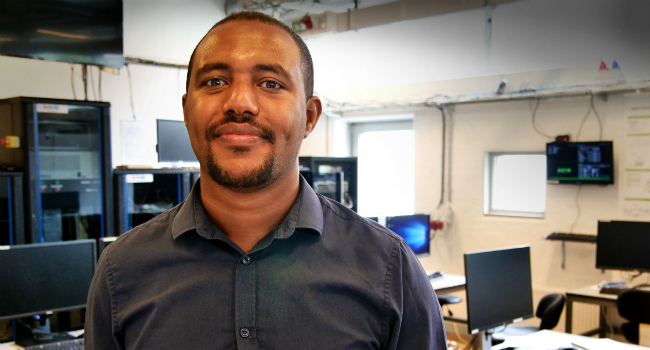Mohammed Seifu Kemal has developed a method that can help power companies ensure a secure and stable electricity supply using existing electricity meters.
The number of solar installations, wind turbines and other alternative forms of energy in Denmark has multiplied in recent years. Green energy is a good thing, but it presents challenges for the grid when customers become ‘prosumers’ (producers and consumers at the same time) and when production, in addition, varies according to weather and wind.
‘This requires accurate monitoring of the grid to make things work. Today, for example, failures in the grid are detected and diagnosed based on customers calling in. Network providers lack the necessary technology to collect the data needed to ensure that the network meets its operational requirements,’ explains Mohammed Seifu Kemal, who recently completed his PhD at Aalborg University (AAU).
Mohammed Seifu Kemal developed the method as part of the Danish project RemoteGRID, a collaboration of Kamstrup, Thy-Mors Energy and Aalborg University as well as the European energy project Net2DG.
Collecting data
Almost all households in Denmark are equipped with an online energy meter – a smart meter. Two to four times a day, the meter sends a message to the power company with an update of the household's consumption. The meters are mainly used to collect data to calculate usage for invoicing, but by applying them in a new way, they can potentially be used to collect important data for monitoring the grid.
The idea behind RemoteGRID is to use the existing meters to provide a much more accurate picture not only of customer consumption, but also in terms of information that can be used for monitoring such as voltage measurement.
‘The meters currently use very little bandwidth to send back limited information that’s basically only used for invoicing. However, simply turning up the data transmissions and making them available in real-time would overload the meter network. Instead, we’ve developed a system that can quantify the quality of the measurements so that we only use those that are most interesting and won’t overload the network with data from the smart meters,’ explains Mohammed Seifu Kemal.
The right filter
The energy supplier Thy-Mors Energy has approximately 45,000 households connected to their grid, but not all of the measurements from the smart meters are equally interesting when it comes to monitoring supply security.
‘What we did,’ explains Mohammed Seifu Kemal, ‘was to look at which households experienced the greatest fluctuations in energy flow. They would typically be those that are physically close to wind turbines or PV installations or those furthest down the energy supply chain. This is where major fluctuations usually occur at first.’
‘All the average, normal households in the middle of the grid with regular consumption are not very interesting when it comes to energy monitoring. But if you charge an electric vehicle at home, heat your house with a heat pump or have solar panels on your roof, there will be greater fluctuations in your consumption. This is important for power companies to know in order to ensure stable energy flow. Our new system makes it possible to only use the data from the interesting households and disregard the others,’ he says.
The new system can thus help power suppliers to solve problems on the grid faster and increase customer satisfaction.
FACTS:
RemoteGRID is a collaboration of the meter manufacturing company Kamstrup, energy supplier Thy-Mors Energy, and the Department of Electronic Systems, Department of Energy Technology and Department of Law at Aalborg University (AAU). The project is supported by energinet.dk through the forskEL programme. Find out more at: https://www.remotegrid.dk
Learn more about the European energy security project Leveraging Networked Data for the Digital Electricity Grid (Net2DG) at http://www.net2dg.eu/
Contact:
- Mohammed Seifu Kemal, PhD, Tel.: + 45 5270 8071,moseifu@gmail.com
- Rasmus Løvenstein Olsen, Associate Professor, AAU (supervisor and coordinator of RemoteGRID), Tel.: + 45 9940 7533, rlo@es.aau.dk
- Nelly Sander, Press Contact, AAU, Tel.: +45 9940 2018, nsa@adm.aau.dk

